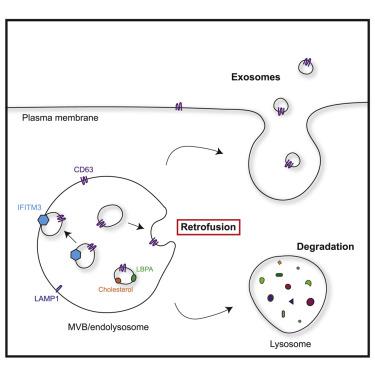Current Biology ( IF 9.2 ) Pub Date : 2021-07-07 , DOI: 10.1016/j.cub.2021.06.022 Priscillia Perrin 1 , Lennert Janssen 1 , Hans Janssen 2 , Bram van den Broek 3 , Lennard M Voortman 1 , Daphne van Elsland 1 , Ilana Berlin 1 , Jacques Neefjes 1

|
The endosomal system constitutes a highly dynamic vesicle network used to relay materials and signals between the cell and its environment.1 Once internalized, endosomes gradually mature into late acidic compartments and acquire a multivesicular body (MVB) organization through invagination of the limiting membrane (LM) to form intraluminal vesicles (ILVs).2 Cargoes sequestered into ILVs can either be delivered to lysosomes for degradation or secreted following fusion of the MVB with the plasma membrane.3 It has been speculated that commitment to ILVs is not a terminal event, and that a return pathway exists, allowing “back-fusion” or “retrofusion” of intraluminal membranes to the LM.4 The existence of retrofusion as a way to support membrane equilibrium within the MVB has been widely speculated in various cell biological contexts, including exosome uptake5 and major histocompatibility complex class II (MHC class II) antigen presentation.6, 7, 8, 9 Given the small physical scale, retrofusion of ILVs cannot be measured with conventional techniques. To circumvent this, we designed a chemically tunable cell-based system to monitor retrofusion in real time. Using this system, we demonstrate that retrofusion occurs as part of the natural MVB lifestyle, with attributes parallel to those of viral infection. Furthermore, we find that retrofusion and exocytosis coexist in an equilibrium, implying that ILVs inert to retrofusion comprise a significant fraction of exosomes destined for secretion. MVBs thus contain three types of ILVs: those committed to lysosomal degradation, those retrofusing ILVs, and those subject to secretion in the form of exosomes.
Video abstract
Download : Download video (11MB)

























 京公网安备 11010802027423号
京公网安备 11010802027423号